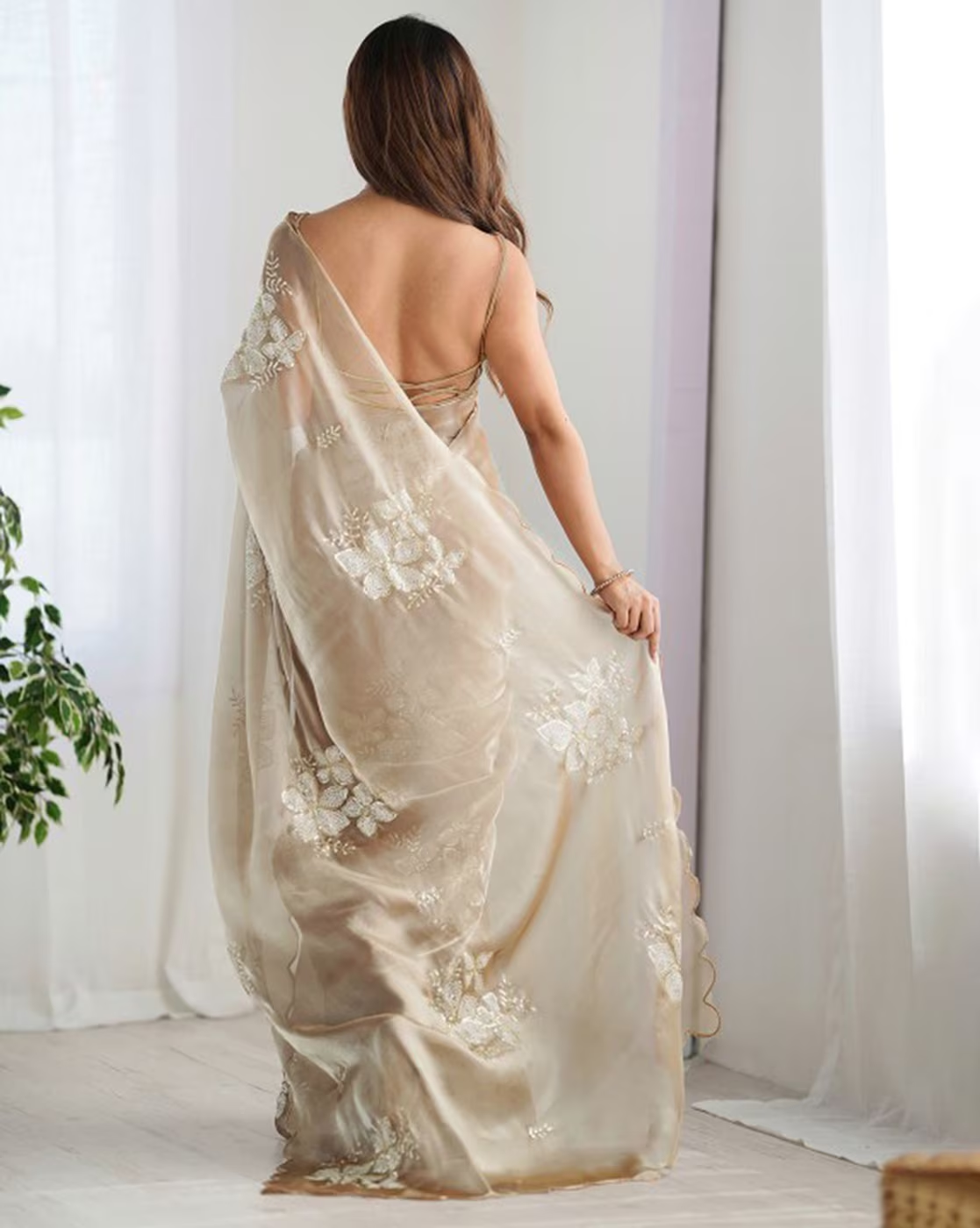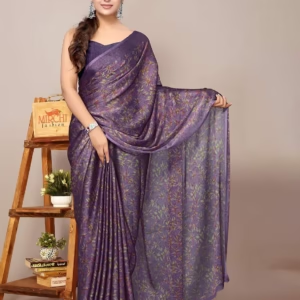A Women Traditional Saree is a timeless and iconic garment that showcases India’s rich cultural heritage. It’s a symbol of grace, elegance, and tradition, often worn for significant occasions such as weddings, festivals, religious ceremonies, and cultural events. The traditional saree is crafted from luxurious fabrics and features intricate designs, making it a popular choice for women who want to embrace the beauty and heritage of Indian fashion.
Features of a Traditional Saree:
- Fabric:
- Silk: The most traditional and luxurious fabric used for sarees. Types like Kanjeevaram, Banarasi, Mysore, and Tussar silk are favored for their opulence and intricate weaving patterns.
- Cotton: A comfortable fabric for daily wear, cotton sarees are breathable and perfect for the summer. They are also used in regional traditional sarees like the Bengal Tant or the South Indian Cotton saree.
- Georgette/Chiffon: Lightweight, flowing fabrics that create a soft drape, often used for formal events or evening wear.
- Satin/Velvet: These fabrics are used for more formal or evening events and provide a rich, smooth finish.
- Organza: Known for its delicate and sheer appearance, often used for bridal sarees or high-end traditional occasions.
- Traditional Weaves:
- Banarasi Silk: Known for intricate brocade work, often featuring motifs like paisleys, florals, and divine symbols. Banarasi sarees are a popular choice for weddings and festivals.
- Kanjeevaram: A type of silk saree from Tamil Nadu, famous for its vibrant colors and rich zari work, especially around the borders.
- Patola: A traditional double-ikat weave from Gujarat, known for its vibrant colors and geometric designs.
- Mysore Silk: Known for its smooth texture and fine finish, this is a popular fabric for traditional sarees worn in South India.
- Chanderi and Maheshwari: These are lightweight traditional sarees with a glossy finish, typically adorned with handwoven motifs.
- Traditional Designs:
- Zari Work: Gold or silver thread work used for embroidery, often seen in the borders or pallu of the saree. Zari enhances the richness of the fabric and makes the saree ideal for formal events.
- Hand-Painted Motifs: Some traditional sarees are adorned with hand-painted designs, like the Madhubani or Kalamkari art styles, representing cultural narratives.
- Floral Patterns: Intricate floral designs woven into the fabric, representing nature and growth, commonly used in wedding and festive sarees.
- Geometric and Paisley Motifs: These motifs are commonly found in traditional sarees, symbolizing balance, beauty, and spirituality.
- Color Palette:
- Rich and Bold Colors: Traditional sarees come in deep, vibrant colors such as red, maroon, gold, royal blue, emerald green, and purple, which are often chosen for auspicious events.
- Pastels and Whites: Lighter hues like cream, beige, soft pinks, and whites are often worn for daytime events, festivals, or spiritual occasions.
- Contrasting Borders and Pallu: Many traditional sarees feature contrasting colored borders and pallu (the loose end of the saree), which add to their visual appeal and elegance.
Styling Tips:
- Traditional Blouse Designs:
- High Neck Blouse: A high-neck blouse works wonderfully with traditional sarees, especially those with intricate embroidery or zari work.
- Backless Blouse: For a modern twist on a traditional saree, opt for a backless blouse to give the outfit a contemporary touch.
- Boat Neck: A boat neck blouse can add a sophisticated flair to the saree, especially if you’re looking to make a statement at an evening event.
- Full-Sleeve Blouse: Traditional sarees often look stunning when paired with a full-sleeve blouse that has detailed embroidery or lace work.
- Jewelry:
- Gold Jewelry: Traditional gold jewelry, such as a necklace, earrings, and bangles, complements traditional sarees perfectly. Kundan, Polki, and temple jewelry are all great choices.
- Silver Jewelry: For a slightly more understated yet elegant look, silver jewelry works beautifully with sarees, especially those with cool-toned fabrics like blues or greens.
- Statement Pieces: Consider adding a statement necklace or choker to enhance the look, or wear jhumkas (traditional earrings) to complete the ensemble.
- Draping Styles:
- Nivi Style: The most common drape, where the saree is wrapped around the waist with pleats at the front and the pallu draped over the shoulder.
- Gujarati Style: In this style, the saree is draped with the pallu coming over the right shoulder, creating a distinct look.
- Maharashtrian Style: In this drape, the saree is wrapped around the body in a dhoti-like style, often paired with a traditional navel-length blouse.
- Bengali Style: The pallu is draped in a more elaborate manner, falling over the shoulder and across the chest, giving the saree an elegant look.
- Footwear:
- Traditional Footwear: Pair your traditional saree with mojaris or juttis for an authentic touch, especially when wearing regional sarees.
- Heels: For an elegant, formal look, you can wear embellished sandals or heels in metallic shades like gold or silver to complement the rich fabric of the saree.
Occasions for Wearing a Traditional Saree:
- Weddings: Traditional sarees are a staple at weddings, whether you’re the bride, bridesmaid, or a guest. Silk sarees, especially Banarasi and Kanjeevaram, are often chosen for such occasions due to their grandeur and intricate designs.
- Festivals: Traditional sarees are often worn during Indian festivals like Diwali, Navratri, Durga Puja, and Holi. Sarees with intricate zari work, floral patterns, or hand-painted motifs are particularly favored during such occasions.
- Religious and Cultural Events: Traditional sarees are ideal for religious ceremonies, poojas, and cultural festivals. They are worn to honor traditions and embrace cultural rituals.
- Formal Gatherings: Whether it’s a corporate event, gala, or charity function, traditional sarees in rich fabrics and vibrant colors can add an air of sophistication and elegance to your attire.
- Daytime and Evening Celebrations: A traditional saree can be worn for smaller family gatherings, birthday parties, or evening celebrations, depending on the fabric and design of the saree.
Why Traditional Sarees are Special:
- Cultural Significance: Every traditional saree is often a piece of heritage, carrying with it a rich history, craftsmanship, and cultural significance. It tells a story of Indian craftsmanship and artistry passed down through generations.
- Elegance and Timelessness: A traditional saree will never go out of style. Whether it’s worn for a wedding, festival, or cultural event, a traditional saree radiates an air of grace and elegance that is hard to replicate with other garments.
- Heirloom Quality: Many traditional sarees are passed down through generations as heirlooms. With their rich fabrics and intricate embroidery, they can last a lifetime and become family treasures.
- Versatility: Despite being a traditional garment, the saree is incredibly versatile. With a variety of draping styles and blouse options, a traditional saree can be styled to suit both classic and contemporary tastes.
Care Tips:
- Washing: Traditional sarees made from delicate fabrics such as silk or satin often need to be dry cleaned to maintain their luster. Avoid washing them at home unless specified.
- Ironing: Always iron your saree on a low heat setting, especially if it’s made from delicate fabrics like silk or chiffon. Iron it inside out to prevent damage to the embroidery.
- Storage: Store your traditional saree in a cool, dry place, away from direct sunlight. If your saree has embroidery or zari work, it’s best to store it in a fabric garment bag to avoid snagging.
- Handling Embellishments: Be gentle when handling sarees with heavy embellishments, as they can get caught or damaged. Fold them carefully to preserve the fabric and designs.
Conclusion:
A Traditional Saree is much more than just a piece of clothing—it’s a symbol of culture, tradition, and timeless beauty. Whether it’s for a wedding, festival, or any significant event, this garment never fails to make a statement. The fabric, design, and craftsmanship all contribute to its elegance and charm, making it a beloved piece in every Indian woman’s wardrobe.
Would you like advice on selecting a traditional saree for a particular occasion or tips on pairing it with the right blouse and accessories? Let me know!








Reviews
There are no reviews yet.